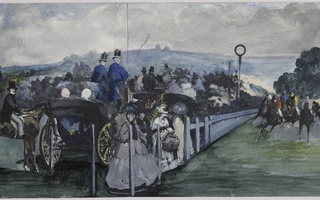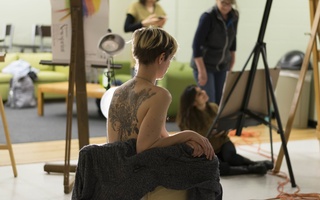Confronted with a smorgasbord of “drawings,” one can’t help but wish that the scope of “Drawing: A Broader Definition” was slightly narrower, or at least more focused. Tucked away within the Museum of Fine Arts, Boston (MFA), the small in-house exhibition takes a kaleidoscopic view of its subject, and spans six millennia and nearly as many continents in 66 objects and 2 rooms. The show is now on display at the MFA through May 4, 2008.
In the exhibition’s introductory text, Clifford S. Ackley, the MFA’s curator of prints and drawings, explains that the show’s “focus is on the sheer pleasure of looking and comparing how different artists in different times and places have inventively [rendered] the same subjects: the human figure, landscapes, birds and animals, fish and flowers.”
There are “drawings” incised in metal, stone and clay; “drawings” on glass; “drawings” on textiles; “drawings” on ceramics; even a “drawing” on a limestone flake. There are also more conventionally-defined “drawings” on paper; a twentieth-century nude by Elie Nadelman shares a wall with works by Jean Auguste Dominique Ingres, Edgar Degas, and an anonymous nineteenth-century artist in Rajasthan, India, among others.
The show is organized thematically rather than chronologically or geographically. The seemingly incongruous juxtapositions create a surreal space in which a punch bowl from a 1931 Cowan Pottery Studio Jazz Bowl Series is a blaze of blue and black abstraction behind a case containing Mayan cylinder vases and Greek oil flasks.
Ackley cites two original sites of inquiry: his desire to look at a Goya drawing next to a Hokusai print and his desire to consider Maya drawings on ceramic vessels next to more familiar ancient Greek drawings. Fittingly, they are also two of the most successful pairings. The bold red Mayan ‘drawing’ offsets the Grecian slighter white figure technique.
It is often the similarities in works across time and place that are most intriguing. A case in the second gallery that houses fish and flowers illustrates this strength. A floral Josef Hoffman design from roughly 1920 echoes both a Chinese vase from the eleventh-century Northern Song Dynasty and a twelfth-century plaque from Cologne—one of the show’s tiny treasures—while the congruence of fish forms in ancient Greek and Egyptian bowls plays well off the Hokusai print beneath.
The objects are well displayed throughout. Many, such as the ubiquitous lead-glazed plates and platters, hang on the walls with the two-dimensional paper works, while others can be found distributed in cases. A plate by Picasso featuring a crude fish with an unsightly abscess of an eye confronts the viewer entering the second gallery.
The cases utilize mirrors to good effect. For instance, a circular mirror reveals the black silhouette of an ancient athlete on the bottom of a Greek oil flask while another makes all of a three-dimensional work visible in lieu of a stand alone case.
However, all together, the show feels less than cohesive. “Five ways to draw a bird” may work well in isolation, but with so many varied themes surrounding the works in the sequence, it is easy to get lost before they can all fully register. Due to issues of space or of scope, or of both, the show feels claustrophobic at times with so many objects, themes, peoples and places clamoring for attention, and so many millennia truncated into so few works.
Yet, given the time and focus, it can be a pleasure to see the works playing off of each other, as Ackley intended.
—Staff writer Anna K. Barnet can be reached at abarnet@fas.harvard.edu.
Read more in Arts
Southland TalesRecommended Articles
-
TENNIS TOURNAMENT CONTINUESThe semi-final round of the singles and the second round of the doubles will be completed at Jarvis Field this
-
Exhibition of Ruskin's Work in FoggAn exhibition of drawings, sketches, and etchings by John Ruskin is being held in the Upper Gallery of the Fogg
-
MANY NEW IMPROVEMENTS OFFSET IMPERFECTIONS IN FRESHMAN RED BOOKThe 1925 Red Book is noteworthy in one respect at least--it is both better and worse than any of its
-
 Studying the Strokes of Greatness at HAM
Studying the Strokes of Greatness at HAM -
 Figure Drawing Class Evokes Empathy
Figure Drawing Class Evokes Empathy













